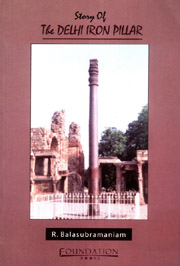2 - History of the Iron Pillar
Published online by Cambridge University Press: 26 October 2011
Summary
Visitors to the Quwwat-ul-Islam mosque in New Delhi are often left wondering about the origin and meaning of the iron pillar that stands in the courtyard. It must first be stated that the Iron Pillar did not originally belong to Delhi. The Quwwat-ul-Islam mosque was constructed by Qutubuddin Aibak between AD 1192 and 1199 and the construction was extended by his successor Iltutmish. While the design and construction of the Quwwat-ul-Islam mosque is Islamic in nature, it was actually constructed by Hindu engineers and artisans. The materials obtained from twenty-seven Hindu and Jain temples that had been destroyed were utilized in its construction. The Iron Pillar was also uprooted from a Hindu religious site and brought to the courtyard of the mosque. As we shall soon see, the Iron Pillar dates back to the period of Indian history that is considered by scholars as the Golden Age of India, namely the Gupta period (AD 320 to 600).
Where was the pillar originally located? What was it meant to represent? Was it merely a religious symbol or did it serve any other purpose? To which era does the pillar belong, and which monarch commissioned its construction? Who moved the pillar to its current location? This chapter is intended to answer these questions. First, an attempt is made to explain the Brahmi inscription found on the pillar. This is followed by a verification of whether it really belonged to the Gupta period, using numismatics and paleography to decipher the clues the pillar gives us.
- Type
- Chapter
- Information
- Story of the Delhi Iron Pillar , pp. 6 - 28Publisher: Foundation BooksPrint publication year: 2005



